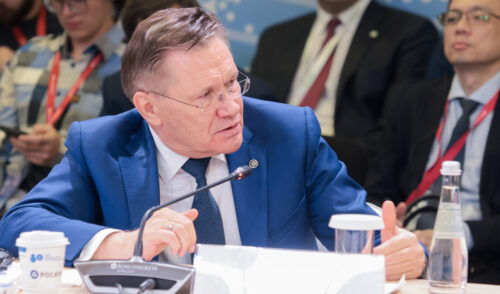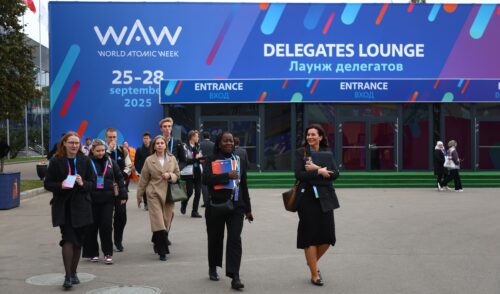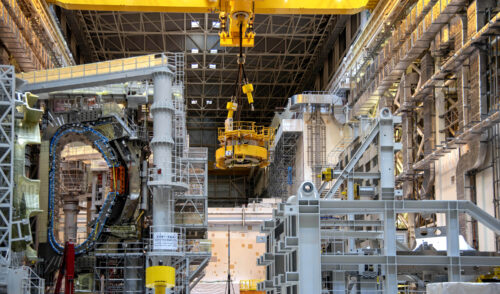The Energy of Science
back to contentsToday Russia is an undisputed leader in amount of research reactors. However it has been the first time in 15 years that the RRFM – European Research Reactor Conference, organized by the European Nuclear Society with the support of Rosatom and Atomexpo – was summoned on its territory. More than 200 specialists came to Saint-Petersburg to share their experience and discuss topical issues.
The highlight of the program was the presentation of MBIR (multipurpose fast research reactor), which is to be built in Dimitrovgrad, Ulianovsk region, at the site of Atomic Reactor Research Institute, the largest experimental complex of civil atomic energy in the RF. An international research center is planned to be built there as well. Rosatom believes that the unique reactor will attract the scientists from all over the world. It is expected that the license for the construction of the successor of the legendary BOR-60 fast breeder reactor, operating since 1969, will be granted by Rostechnadzor (Federal Service for Ecological, Technological and Atomic Supervision) as early as next autumn. MBIR’s companion in international partnership is the PIK reactor, whose physical start-up took place in 2011 in St. Petersburg Nuclear Physics Institute.
The power start-up is to follow: the final decision will be made by the end of this year or early next year. Kir Konoplev, the research supervisor, reported his estimations about PIK doing 100 MW as early as this November. There’s no need to delay the start up, he says, since the German colleagues have already sent their equipment for research. “PIK is the reactor designed for international cooperation. “The amount of neutrons and research plants that we possess today is much more than one institute can handle” – the scientist explains.
Almost Anew
Research plants working in Russia these days are in big demand abroad. Thus, according to Nikolay Archangelsky, Rosatom Innovation Department Counselor, the BOR-60 and MIR reactors are performing many foreign orders.
“We shouldn’t forget either about IBR-2M neutron reactor located in Joint Institute for Nuclear Research in Dubna (international non-governmental research organization working in the following fields: nuclear, particle and condensed matter physics). For some research this reactor is excellent, with no analogs on the international market. However there still are some restrictions since no reactor is universal”, – says Archangelsky. By the way, IBR-2M reserved a separate speech given by the Head of Nuclear Safety Group of the Joint Institute for Nuclear Research, neutron physics laboratory, Yury Pepelyshev. IBR-2M has one of the highest neutron flux. There were several reactor projects of this type in the world, but only the one in Russia has been completed with success.
In fact, there is a new IBR-2M put into operation in Russia these days, it was seriously modernized, and in quite a short period of time – within four years. Everyone understood the necessity of the measures. “Although the reactor was created 25 years ago, the assembly fully corresponds the world’s standards. Rosatom helped us, besides we used our own resources. Since the institution is joint, the financing was also drawn from the partner-countries ” – says Pepelyshev. The active zone of the reactor was fully replaced (it became smaller), as well as the pile assembly and near areas, safety system and movable reflector.
“For another 20 years IBR-2M will be working safely as a source of neutrons, – says Yury Pepelyshev. – This kind of flows one can never get on other plants”. There is always a queue of experimentalists, the time is scheduled by hours. “For example, one day there are Germans coming, working and going, the next day there is someone else. Cooperation here is really close”, – says the scientist. IBR-2M gives us unique opportunities, especially from the point of view of material engineering; stress loads, in particular.
Know-How for Export
Besides international cooperation Rosatom pays close attention to commercialization of its developments abroad. Thus the Research and Development Institute of Power Energy (NIKIET), one of the biggest Russian centers for nuclear technologies, presented three business projects at the conference. The first one was a teaching research water-water 1 MW reactor. “This device is relatively small and not expensive, with quite reasonable operation costs”, – says Igor Tretyakov, NIKIET Chief Designer for Research and Isotope Reactors . With its help we can conduct various kinds of research and train specialists”.
The second project is a multipurpose 15 MW research reactor, specializing in solid state physics, reactor material engineering and getting wide range of isotopes for medicine and industry, with the construction itself and experimental devices changing upon the customer’s order. And, finally, the third NIKIET product for export can be the nuclear-technological complex for medical isotopes, including two pile assemblies with uranyl sulphate water solution as a fuel. The potential markets are considered to be Eastern Europe, Africa, Latin America and Eastern Asia.
“We bank for all three reactors. There are clients needing purely commercial production and others – something totally different”, – says the Chief Constructor. “We hope that everything we are showing at the conference will be welcomed by the nuclear society, – summed up Nikolay Archangelsky. – “Personal contacts mean a lot. We also hope that our practices will be in a bigger demand. Our cooperation with foreign colleagues is long-standing and close, implying fuel, new developments, experimental use of research reactors. However some newcomers today are also getting interested in Russian technologies”.




